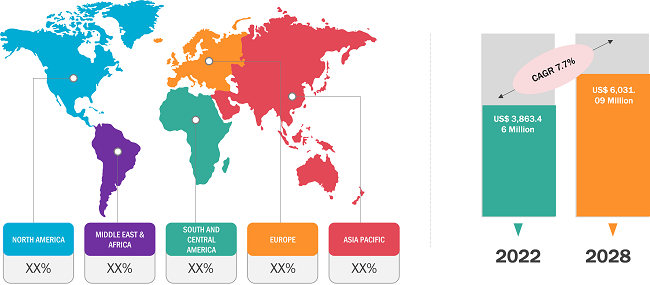Rapid Advancement in Laser Technology is Catalyzing Surgical lasers Market Growth
According to our latest market study on "Surgical lasers Market Forecast to 2028 – COVID-19 Impact and Global Analysis – by Type, Procedure, and Application," the market is expected to grow from US$ 3,863.46 million in 2022 to US$ 6,031.09 million with an estimated CAGR of 7.7% from 2022 to 2028.

Surgical Lasers Market by Size, Share & Trend Analysis 2031
Download Free SampleSurgical Lasers Market Size and Forecasts (2021 - 2031), Global and Regional Share, Trends, and Growth Opportunity Analysis Report Coverage:By Type (Carbon Dioxide (CO2) Lasers, Argon Lasers, ND:Yag (Neodymium:Yttrium-Aluminum Garnet) Lasers, Diode Lasers, and Other Surgical Lasers Connected Sensors), Procedure (Open Surgery, Laparoscopic Surgery, and Percutaneous Surgery), Application (Ophthalmology, Dermatology, Dentistry, Urology, Cardiology, Gynecology, Oncology and Other Applications), and Geography
Laser surgery is a type of surgery that utilizes special light beams instead of surgical instruments for surgical procedures. With the advancement in medicine, lasers are increasingly used to treat a variety of diseases as they are less invasive. Laser treatment is widely used in areas such as cancer, tumor ablation, dermatology, skin rejuvenation, lipolysis, cardiology, atrial fibrillation (AF), and epilepsy. Key factors such as technological advancements in surgical lasers, rise in the prevalence of chronic diseases such as cancer and ophthalmic disorders, and increase in preference for minimally invasive surgeries are catalyzing the global surgical lasers market growth in the current times.
Rapid advancement in laser technology and high prevalence of vision impairment will foster the global surgical lasers market trends through 2028. As per the WHO, over 2.2 billion people have a distance or near vision impairment globally. This factor could proliferate the need for LASIK eye surgery, which accounts for 90%-95% of all laser vision correction surgery. Developments in laser technology designed to target serious ailments like cancer will also add impetus to industry expansion. In 2021, the Engineering and Physical Sciences Research Council provided a US$ 1.6 million fund to the Heriot-Watt University in Edinburgh for developing a new laser system to help surgeons distinguish and remove cancer cells without damaging nearby tissues. Such noteworthy investments in the treatment of targeted diseases will also fuel the requirement of surgical laser machines in the upcoming years.
Moreover, increasing demand for minimally invasive or noninvasive procedures and rising patient inclination toward reduced hospital stay are pushing manufacturers to develop products and equipment that are technologically advanced and offer faster recovery. This is boosting the competitive rivalry with new product launches. For instance, in July 2018, Candela Corporation received the US Food and Drug Administration approval for its Vbeam Prima, a Pulsed Dye Laser (PDL), which is used for a wide range of skin conditions such as rosacea; acne; facial; leg, and spider veins; scars; port wine stains; warts; stretch marks; and wrinkles.
The increasing adoption of dental lasers due to their surgical benefits and growing initiatives by developers to raise awareness about dental treatment benefits through lasers are some of the driving factors for the global surgical lasers market. For instance, in February 2018, Biolase, Inc. announced initiatives to enhance dental laser awareness by offering educational courses in laser dentistry, thus, helping dentists in providing optimal care to the patients.
The growing awareness about advanced aesthetic procedures is an important factor leading to increasing acceptance and demand for advanced cosmetic procedures across the world, both in developed and developing regions. In recent years, there has been a significant surge in the number of cosmetic procedures that involve surgical laser equipment. According to the data from the American Society of Plastic Surgeons (ASPS), the US reported around 17.7 million cosmetic procedures in 2018. These included surgeries and minimally invasive procedures. The source further states that these procedures increased by 200% from 2000.
The COVID-19 pandemic caused major disruptions in cancer care, owing to delayed diagnosis and treatment. Treatment pathways were altered to lower the risk of infection during surgery and radiation therapy, which created a hindrance to the steady growth of the industry in 2019- 2020. However, the gradual increase in the acceptance of refractive surgery, post-crisis, may help the industry regain traction in the coming years. The high emphasis on public health and safety amid the pandemic indirectly influenced people to re-evaluate their eye health. Situations such as these have given rise to the deployment of laser vision correction procedures, thus, contributing to the overall industry dynamics. Thus, the decline in laser surgical procedures for major applications in 2020 is one of the major factors for the revenue loss in the global surgical laser market.
The global surgical lasers market report summarizes detailed information by top players such as Lumenis Be Ltd, Cynosure, Alma Lasers, Abbott, Boston Scientific Corporation, IPG Photonics Corporation, Spectranetics Corporation (Koninklijke Philips N.V.), biolitec AG, BISON MEDICAL, and Fotona. Several other major companies were studied and analyzed during this research study to get a holistic view of the global surgical laser market and its ecosystem.
Contact Us
Phone: +1-646-491-9876
Email Id: sales@theinsightpartners.com